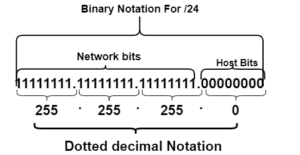Subnet masks play an important role in optimizing network management by dividing large IP address ranges into smaller, more manageable subnetworks. This not only enhances IP address utilization but also prevents waste in smaller networks.
In this post, I will show you how to determine the subnet mask of an IP address.
Note: It is not possible to determine the subnet mask of an IP address, like 192.168.1.10 without additional information such as prefix length or network addresses. Just be aware of that.
How to Determine the Subnet Mask of an IP Address using Prefix length
If you’re given the prefix length of an IP address, then finding the subnet mask is very easy, you can either look up the subnet mask on the subnet mask cheat sheet or follow the steps below to determine the subnet mask. We will be using 192.168.1.10 with prefix length of /24(ie a CIDR notation of 192.168.1.10/24) to do the demonstration.
Step 1: Determine the Network and Host Bits
The prefix length, denoted as “/24” in this case, specifies the number of network bits. For a “/24” prefix length, there are 24 network bits, leaving 32 – 24 = 8 bits for hosts.
Step 2: Write the Binary Representation
Represent the subnet mask in binary form by setting the network bits to “1” and the host bits to “0”.
In the case of a “/24” prefix length:
- Network bits: “11111111.11111111.11111111”
- Host bits: “00000000”
Combine them to get the binary representation:
Binary Representation: "11111111.11111111.11111111.00000000"Step 3: Write the dotted decimal representation
Once you have the binary representation, you can get the subnet mask by converting the b binary representation to a dotted decimal. In the case of the /24 prefix length, the dotted decimal representation, which is the same as the subnet mask, is 255.255.255.0.

How to Determine the Subnet Mask of a Network Address
If you’re given a network address, such as 192.168.2.0, and tasked with finding the subnet mask, follow these steps:
- Identify Non-Zero Octets:
- Examine each octet in the given network address.
- Identify octets with values greater than 0.
- Replace non-zero octets with 255:
- For each octet identified in step 1, replace its value with 255.
For example, for the network address 192.168.2.0:
- Replace 192 with 255.
- Replace 168 with 255.
- Replace 2 with 255.
- Leave 0 unchanged.
- Write the subnet mask:
- Combine the modified octets to form the subnet mask.
Using the example:
- Subnet Mask: 255.255.255.0
By replacing non-zero octets with 255, you derive the subnet mask associated with the given network address.
Example:
Find the subnet mask of the network address; 10.2.0.0
Here are steps to find the subnet mask of the network address 10.2.0.0;
- Identify Non-Zero Octets:
- Examine each octet in the given network address (10.2.0.0).
- Identify octets with values greater than 0.
In this case, the first and second octets are non-zero (10 and 2).
- Replace Non-Zero Octets with 255:
- For each identified octet, replace its value with 255.
Replace 10 with 255. Replace 2 with 255. Leave 0 unchanged.
- Write the Subnet Mask:
- Combine the modified octets to form the subnet mask.
The subnet mask is 255.255.0.0.
So, the subnet mask for the network address 10.2.0.0 is 255.255.0.0.

I am a passionate Networking Associate specializing in Telecommunications.
With a degree in Electronic engineering, I possess a strong understanding of electronic systems and the intricacies of telecommunications networks. I gained practical experience and valuable insights working for a prominent telecommunications company.
Additionally, I hold certifications in networking, which have solidified my expertise in network architecture, protocols, and optimization.
Through my writing skills, I aim to provide accurate and valuable knowledge in the networking field.
Connect with me on social media using the links below for more insights.
You can contact me using [email protected] or connect with me using any of the social media account linked below



